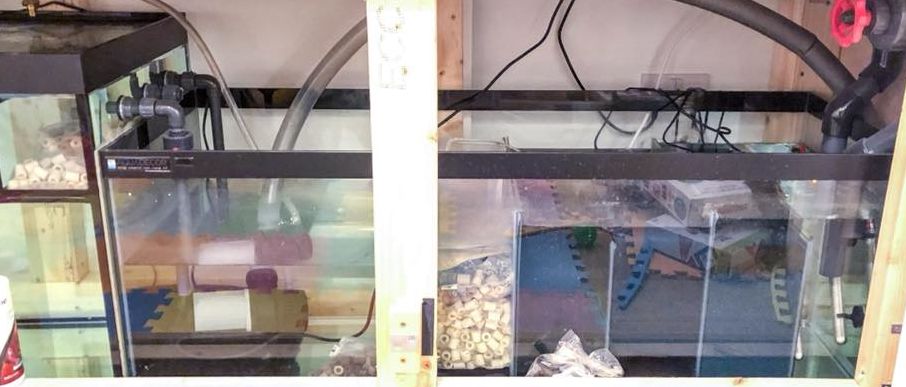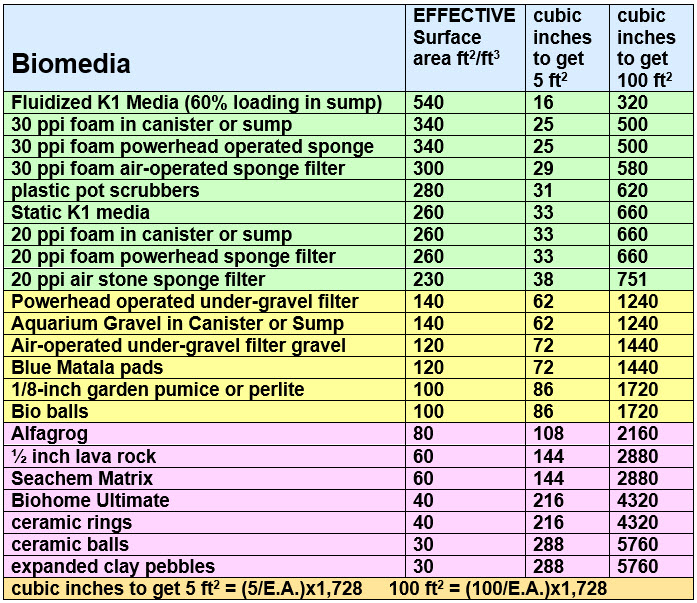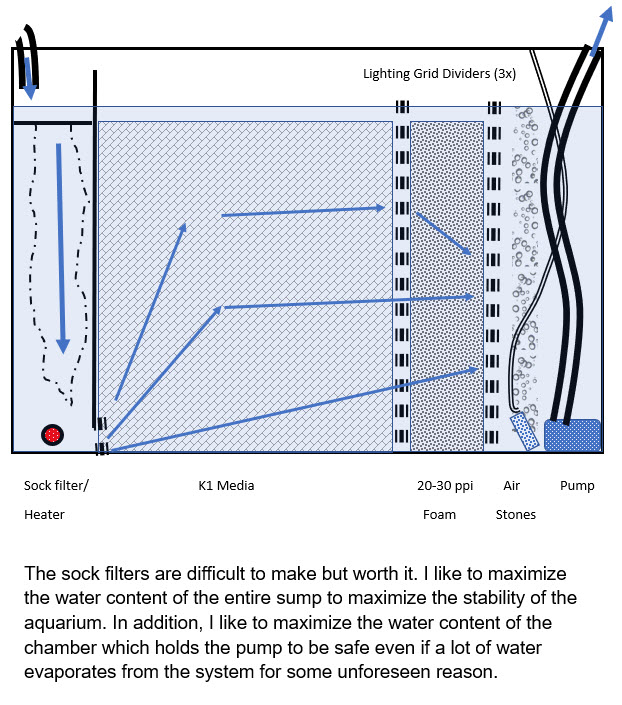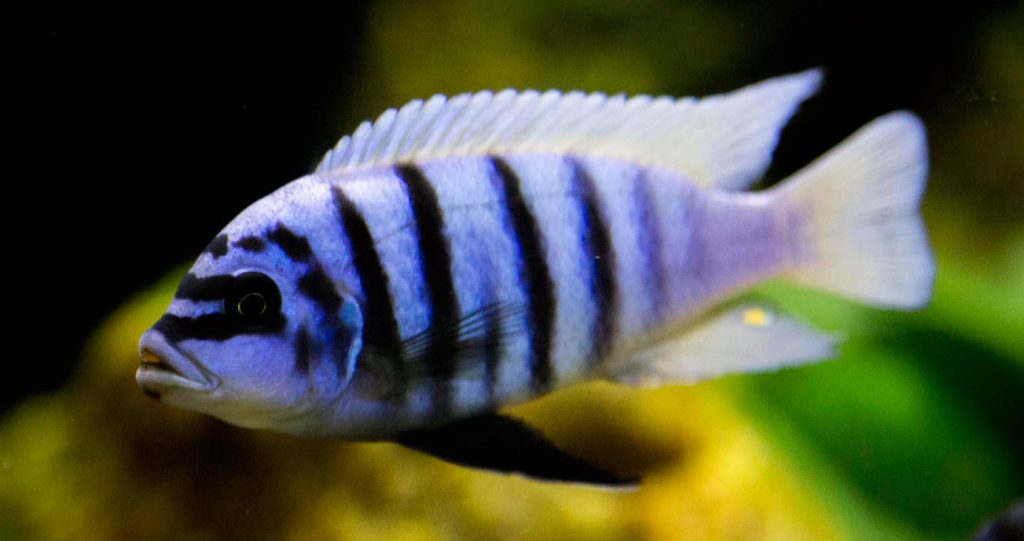
Static submerged media sump filters are simply sumps filled with both water and a biomedia through which the water flows. Most sump filters in the hobby are static submerged media sumps. These are like all submerged media filters in that the load of fish they can successfully filter is dependent on the media that one fills them with.
Media in a Submerged Sump Filter
Filter biomedia vary by the amount of effective surface area they give for beneficial bacteria to grow on. Note the term “effective” is very important. Many media suppliers report their surface area as what a nitrogen molecule can get too. Since a nitrogen molecule is a billion times smaller than any beneficial bacteria this is VERY misleading. The square feet of surface area per cubic foot of biomedia (ft2/ft3) actually available for colonization by beneficial bacteria is:


Now a simple illustration is in order. Elsewhere we establish that fish are very healthy and well taken care of by a biofilter media which has very roughly 100 square foot of biomedia surface area per pound of fish. And very roughly 5.5 five-inch fish are in a pound of fish. A typical 40-gallon sump might have 24 gallons of submerged biomedia in it, or 3.2 cubic feet.
So foam in the submerged biomedia sump will support 3.2 x 400/100 or 12.8 pounds of fish or and astonishing 70 five-inch fish. Matrix, Biohome or ceramic rings in the submerged media will support 3.2 x 30/100 or 1 pound of fish or 6 five-inch fish. This is really a very astonishing calculation all sump owners should do.
Note that for reasons we will delve into under fluidized bed sumps a 40-gallon fluidized bed filled with 3.2 cubic feet of 60% K1 media and properly circulating with air will filter the water and keep in excellent health an astonishing 104 five inch fish.
Design of a Submerged Sump Filter
The simplest design for a static submerged media sump is:

Other submerged setups are shown below:

.

.

.
Many commercial filter sumps are designed for saltwater aquariums and have protein skimmers and refugiums. These are unnecessary in a freshwater sump filter.
Filter sumps are customized in a hundred variations. Every aquarium owner has their own opinion as to the best filter sump design. That’s the nature of an “aquarium geek”.
Some have complained that if the mechanical filtration media becomes clogged the filter sump will overflow onto the floor. There are some small commercial units which can do this. This is a defective design. All good filter sumps are designed so that a clogged mechanical filter will only result in water pouring over into another part of the sump, bypassing some or all the filtration media.

There are some sump filter designs where the mechanical filtration (polyester pads) is after the biological filtration. There are also many sumps where the biomedia only fill a small portion of the sump. These are very inefficient designs.
Most sump users have bags of media in the sump which have four or more types of media in the bags (one YouTube presenter had eight different types of media!). Apparently, they feel each biomedia will have an advantage. All biomedia do the same thing, they just do it with varying degrees of success. This use of a large variety of media is just somewhat humorous but EVERYONE does it.
This sump has eight types.

Note how the chambers with the K1 are only partially filled with media in this sump. This is to make this chamber a fluidized bed. This is the best type of filter to use by far. But the chamber should be filled with K1 at a 60% level. This looks to be only 20% or so. This flow is down-up three times though six chambers. The small final two chambers are where the pump is located. So there is a sizable danger that evaporation will cause a dry pump failure with this design.
Sumps in More Depth
For more information on other types of sumps click on these links:
8.6.1. Sumps in Depth
8.6.3. Trickle Filters
8.6.4. Wet-dry Sumps
8.6.5 Fluidized Bed Sumps
8.6.6. Do-it-yourself Sump
A variation of the static sump designs above is a very attractive method of filtration. It is a “foam sump” that is very simple in design and in operation. The article about these types of sumps is:
8.6.7. Foam Sump
Note that many beginners are concerned about how to flow the water to a sump. The common refrain is “my aquarium isn’t drilled, how does the water get to the sump?” Click on this link to get some ideas:
14.7. Overflow Devices

.
Return to Filter Menu
Return to Sump Filter Menu
.
Aquarium Science Website
The chapters shown below or on the right side in maroon lead to close to 400 articles on all aspects of keeping a freshwater aquarium. These articles have NO links to profit making sites and are thus unbiased in their recommendations, unlike all the for-profit sites you will find with Google. Bookmark and browse!
.

Anonymous says
Thanks for your reply & pretty much what I thought.
The effort you have put into your resource material is exceptional & gives so many of us valuable information, to not only get started, but also to advance if we so choose.
I’m so looking forward to the day when the water is crystal clear, as I’ve never been able to achieve that, but then I’ve never had the benefit of your insight & experience.
All the best,
John
Dave says
There are just far too many variables to predict when you will get crystal clear water. But your sump should give you crystal clear water all by itself at some point.
John henry says
Hello David,
First, thanks for such a great resource….much appreciated you sharing your knowledge.
A question on my set up if I may?
This is a new tank set up & the main tank is 48 x 18 x 20 inches high.
It drains to a sump that has 15 gallons of 25ppi foam via a 1200lph pump. I also have a small internal canister filter (400lph) purely for surface agitation. ( exits via a spray bar). The main pump exits at the surface & provides good surface agitation.
The tank has been running for 2 months & has gone through the cycle as far as the API tests go, that is, 0 ammonia, 0 nitrite & now 0 nitrate. Temp is 25deg & PH is 7.5.
I have 2 zebra Danios & 2 Platys which I used initially to help cycle the tank before adding more stock. (no other stock in there at the moment).
My question is that the water is not crystal clear. From the front it looks clear, but looking from either end it is slightly murky. How long does it normally take to clear up completely?
I know……”PATIENCE, PATIENCE, PATIENCE”
I was considering installing an UGF to help, but don’t really want to strip everything down.
Thanks again for your efforts to help us fellow aquarists.
Regards,
John